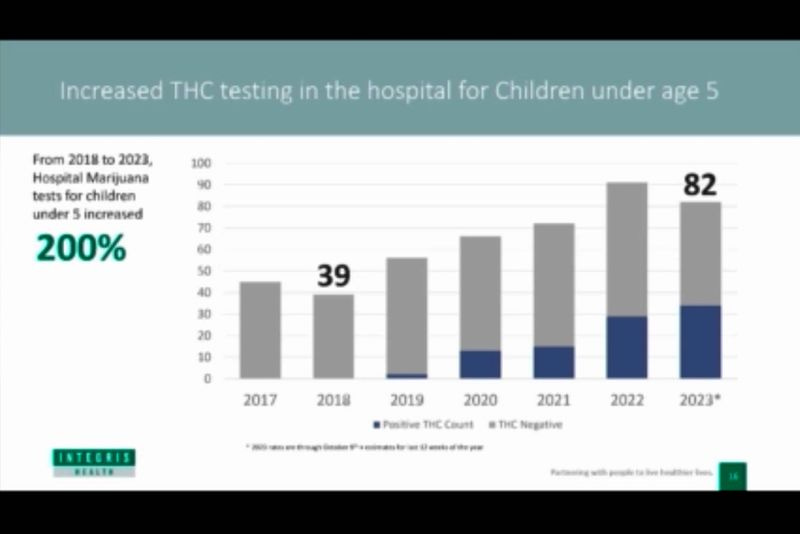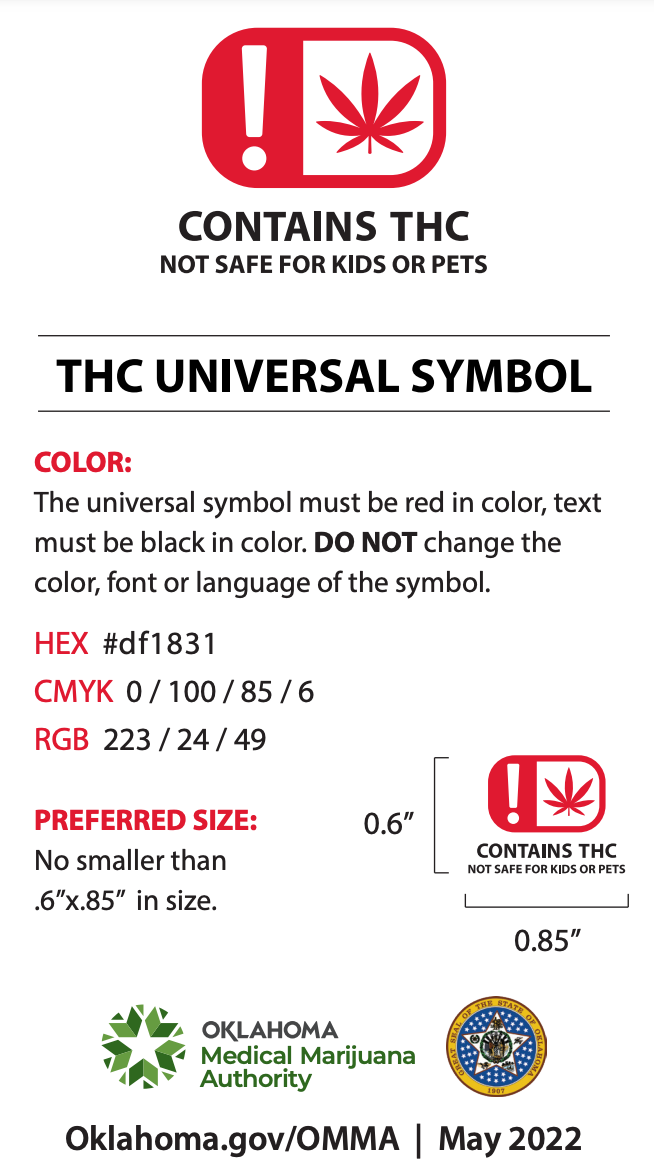Representative Roe holds Pediatric Edible Cannabis Exposure Interim Study
What was originally planned about kids and edibles became an airing of grievances about patient consumption habits, common cannabis myths, and more.
Oklahoma State Rep. Cynthia Roe, R-Lindsay, called for an interim study, analyzing cannabis ingestion by children. The Alcohol, Tobacco and Controlled Substances committee met Monday November 6 and heard from medical professionals and health agencies.
Throughout the hearing there were some facts, and also it seemed, some opportunities for legislators to sneak in some classic talking points.
Poison center calls were covered, and it was stated that The Oklahoma Poison Center received 269 calls pertaining specifically to pediatric marijuana exposure in 2022.
Before the SQ820 vote in March 2023, NonDoc covered edibles and Poison Center data comparatively as it was a major talking point in from the PAC asking Oklahomans to vote against the question. In 2022 the Oklahoma Poison Center received substantially more calls about household cleaning products alone than cannabis edibles, more calls about non-cannabis drugs and tobacco, and about the same for OTC cold meds. Cannabis exposure calls to the poison center in 2022, when compared to other types of exposure of every day products, “paled in comparison”.

During the Integris presentation it was noted that there was not really testing for THC in children before 2018 due to “lack of suspicion”. SQ788 was passed via popular vote in June 2018. Integris brought very little pre-SQ788 data nor was asked how their testing compared statistically to admissions or data before the question passed.

Lee Rhodes with OMMA was one of the speakers who cited research with nationwide trends in pediatric cannabis edible exposure, specifically. Rhodes pointed out that 90.7% of the cases of ‘pediatric edible cannabis exposure’ occur in their own residence and that "Education efforts toward parents and safe storage options are emphasized".
Roe asked questions of OMMA about fentanyl, and if they are seeing “fentanyl-laced marijuana” among the exposures. Rhodes responded with “We’re not seeing this in the state right now” to which Roe retorted, “Oh so it’s just in the illegal marijuana?”
“Fentanyl laced marijuana” is not really a thing- there is no situation where a benefit for traffickers exists here. As usual for good fentanyl misinformation checking, we recommend the toxicologist Ryan Marino who has been quoted in numerous pieces addressing misconceptions in fentanyl reporting, and pieces like this one from Filter Magazine that note how dosing with the usual methods of cannabis consumption is not really that practical or this extensive High Times piece that also follow the path of misinformation making fentanyl in weed a moral panic.
The fentanyl-laced weed myth picked up steam in 2017, when Hamilton County, Ohio coroner Dr. Lakshmi Sammarco said in a press conference that “we have seen fentanyl mixed with cocaine, we have also seen fentanyl mixed with marijuana.”
But after follow-up scrutiny in a Vice piece, Sammarco was forced to admit that she had not seen evidence of fentanyl-laced cannabis, just parroting what her co-presenter, U.S. Senator Rob Portman, had told her. -High Times (2021)
“There’s this mistaken belief that law enforcement are experts on the drugs they are seizing,” Beletsky said. “That’s just not the case, and that’s part of the problem.” -Buzzfeed News (2019)
Other questions came up in the hearing where lawmakers assumed behavioral patterns of parents with access to cannabis- one asked if it was known if it was a behavior for a parent to give cannabis to a fussy baby. The question does set up a narrative for anyone listening to the hearing that parents might do this however, similar to the old wives’ tale of giving whisky to a crying or teething baby.
OMMA is asked if THC caps would help at all. This bit of questioning comes as THC caps are being lobbied to lawmakers (again) for the 2024 session by prosecutors and law enforcement. Capping THC is generally not supported in a medical cannabis program, but for some reason it is something various interest groups want for Oklahoma’s program.
These lines of dialog led into lawmakers pivoting to questions about why patients were not policed and punished within Oklahoma’s medical program more aggressively, and by OMMA directly.
“You guys aren’t doing anything to the person,” asserted Roe, to which OMMA’s chief of staff Barrett Brown stepped up to note their scope.
“We enforce on the businesses” and the panel (various) re-iterated possession limits within the state statutes, as they were asked about tracking patient purchases and stopping patients from making purchases. It was reminded that the possession limit is a state statute enforced by other agencies in different ways, though it seemed like some on the committee really wanted to punish patients for their medical use in this line of questions and comments.
Another member from the committee gave comment to complain about a neighbor’s grow operation. This has been addressed already, Oklahoma’s licensed cannabis growers are decreasing substantially due to new laws and industry requirements; he’s a little late. Jessica McGuire with OBNDD spoke on their enforcement actions, and it was noted that they have been actions specifically toward grows, she did not recall any busts or raids on processors.
The committee quibbled for a few minutes over what makes packaging “child resistant” including looking at some photos OBN has brought on slides saying they do not appear to be ‘child resistant’. It is important to note that OMMA compliant packaging has a specific symbol on it and some products seized do not bear this symbol— out of market products they won’t have the Oklahoma universal symbol but perhaps the “THC!” symbol in a triangle with a “CA”/California state logo or something else — Oklahoma’s is more oval or rectangle-with-curved-corners shaped, with more text and specific color and size requirements, and a guide for licensees and patients alike is located on OMMA’s forms page of their website

Once aware of what the symbol looks like, it’s more easily spotted on products both legal and compliant within Oklahoma’s medical cannabis program, and easier to spot the not-so-compliant.

It was asked of the panelists if plain packaging might be better, as a possible suggesting for legislation. Pre-packaging and THC limits are still floating around at this time, and also it has been mentioned “What if patients are to watch a video about the ‘dangers’ of cannabis and take a brief test after?” and a fee increase to the patient licenses (yes patient licenses) was also mentioned after this point. Lockbox programs were mentioned as well, but the classic “how are you going to pay for that” line followed it, spoken by the very people who appropriate these agencies.
As the hearing concluded, Rep. Marti finalized comments expecting they will have “4 to 16 bills” then narrow them down to around two; this is pretty typical of how the cannabis bills go each session, several are filed then they are tapered down via committee substitutes, amendments and shucking, but from this study we can get an idea of how lawmakers may seek to further restrict the program in the 2024 session.
Most bills to restrict cannabis on the OK Legislature House side end up in the Alcohol Tobacco and Controlled Substances Committee sooner or later, we will continue to track them here and you can follow the blog or elsewhere with us on reddit or X/twitter or bluesky also.




